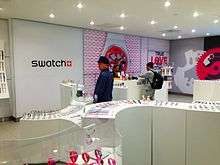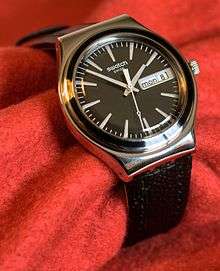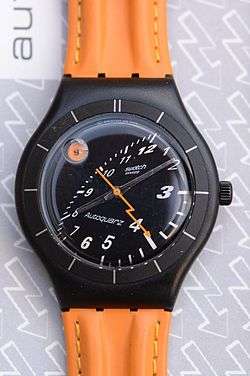Swatch
|
| |
| Subsidiary | |
| Industry | Watchmaking |
| Founded | 1983 |
| Founder | Nicolas Hayek |
| Headquarters | Biel, Switzerland |
Key people | Nick Hayek, Jr. (Chairman, President) |
| Products | Wristwatches |
| Parent | The Swatch Group |
| Subsidiaries | Flik Flak |
| Website |
www |
Swatch (stylized as swatch) is a Swiss watchmaker founded in 1983 by Nicolas Hayek and a subsidiary of The Swatch Group. The Swatch product line was developed as a response to the "quartz crisis" of the 1970s and 1980s, in which Asian-made digital watches were competing against traditional European-made mechanical watches.
The name Swatch is a contraction of "second watch",[1] as the watches were intended as casual, disposable accessories.[2]
History


Swatch began development in the early 1980s, under the leadership of the then ETA SA's CEO, Ernst Thomke with a small team of watch engineers led by Elmar Mock and Jacques Müller.[3]
Conceived as a standard timekeeper in plastic, Franz Sprecher,[4] a marketing consultant hired by Thomke to give the project an outsider's consideration, sought to create a trendy line of watches with a full brand identity and marketing concept.
Swatch was originally intended to re-capture entry level market share lost by Swiss manufacturers during the quartz crisis and the subsequent growth of Japanese companies such as Seiko and Citizen in the 1960s and 1970s, and to re-popularize analog watches at a time when digital watches had achieved wide popularity.
In 1983, the group hired Jacques Irniger - who formerly served as the marketing executive for Colgate, Nestlé- to launch the swatch.[5]
In 1997, the Swatch group opened about 60 stores worldwide.[5]
The first collection of twelve Swatch models was introduced on 1 March 1983 in Zürich, Switzerland. Initially the price ranged from CHF 39.90 to CHF 49.90 but was standardized to CHF 50.00 in autumn of the same year. Sales targets were set to one million timepieces for 1983 and 2.5 million the year after. With an aggressive marketing campaign and relatively low price for a Swiss-made watch, it gained instant popularity in its home market of Switzerland. Compared to conventional watches, a Swatch was 80% cheaper to produce by fully automating assembly and reducing the number of parts from the usual 91 or more to only 51 components.[6]
Lebanese entrepreneur, Nicolas G. Hayek, who, with a group of Swiss investors, took over a majority shareholding of Swatch during 1985 in the newly consolidated group under the name Societe Suisse de Microelectronique et d'Horlogerie, or SMH, became Chairman of the board of directors and CEO in 1986 (who later significantly changed its name to Swatch Group), further masterminded its development to reach its now major worldwide Swiss watch brand status within the lower end of watch prices.
This combination of marketing and manufacturing expertise restored Switzerland as a major player in the world wristwatch market. Synthetic materials were used for the watchcases as well as a new ultra-sonic welding process and assembly technology. The number of components was reduced from 91 or more to 51, with no loss of accuracy.[6]
Product lines


There are families under the Swatch brand:
Swatch Originals
The Originals are plastic-cased watches. They are available in various sizes, shapes, and designs. The Originals consist of various sub-families as well.
Swatch Irony
The Irony family contains all the metal-cased watches produced by Swatch. These include both quartz driven and serviceable, automatic mechanical watches. The automatics have a 21J/23J ETA 2842 movement. This movement is exclusive to Swatch and is derived from 2824-2.
Irony Chronograph was introduced in Aug 2013.
Swatch Skin
The Skin family contains two sub families: Original Skin and Skin Chronograph. The Original Skin was introduced on 6 October 1997 as a thinner version of the original Swatch watch. It is ultra thin, standing at 3.9 mm, hence the name Swatch Skin. The Swatch Skin later went on to enter the Guinness World Book of Records as the world's thinnest plastic watch. The Swatch Chronograph is simply the Swatch Skin with a chronograph function, adding two additional buttons on the side of the watch.
Swatch Bijoux
The Bijoux line is the jewelry line that Swatch released in the new millennium. It partnered with Swarovski to encrust the Bijoux line of watches.
Swatch Digital Touch
The Digital Touch line, launched in 2011, derives its name from the touchscreen technology used. In contrast to other Swatch families, a digital LCD shows the time. Various models in different colors of the display are available, which include backlighting for reading in the dark.[7][8]
Swatch Bellamy and Pay
These Swatch models of wristwatches with a quartz movement are additionally equipped with a near-field communication (NFC) chip to accommodate contactless payment. In November 2015, Swatch and Visa Inc. announced a partnership to enable NFC financial transactions using the Swatch Bellamy wristwatch.[9] As an improved second generation, Swatch introduced model Pay for the Chinese market in July 2017. Unlike the Bellamy, model Pay can be programmed and activated in Swatch shops using a Cloud Computing service operated by several Chinese banks.[10]
Swatch Sistem51
Swatch introduced Sistem51 at Baselworld 2013 as "the world's first mechanical movement with entirely automated assembly."[11] The movement uses 51 components anchored to a central screw with automatic winding and a 90-hour power reserve — and is 100% Swiss made on a 65-foot-long automated assembly line in clean-room conditions, without human intervention.[12]
The movement is permanently sealed in its case with structural adhesive securing both the acrylic crystal over the dial and the caseback, making it invulnerable to environmental conditions including moisture, dust or foreign objects — and also making it maintenance free, i.e., impossible to service.
The movement is made from ARCAP, an anti-magnetic alloy of copper, nickel, and zinc — designed to free the movement from adjustment. The escapement has no manual adjustment or regulator; the initial rate is factory laser-set. Swatch reports precision of -5/+5 seconds per day.[13] The design's peripheral bi-directional rotor allows viewing of movement components through the caseback.[11]
See also
References
- ↑ The Amazing Adventures of the «Second Watch»
- ↑ Company Info History The Swatch Group today the swatch group
- ↑ "The Swatch co-inventor welds wood – and bones". Lunch over IP. 14 May 2008. Retrieved 11 April 2010.
- ↑ Brands: the logos of the global economy – Google Books. Books.google.com. Retrieved 11 April 2010.
- 1 2 Donzé, P. (2014-04-08). A Business History of the Swatch Group: The Rebirth of Swiss Watchmaking and the Globalization of the Luxury Industry. Springer. ISBN 9781137389084.
- 1 2 Bold, Kathryn, "Swatchdogs on the Lookout : Promos give collectors a chance to meet the inventor and pick up some of the 'vintage' timepieces for face value", Los Angeles Times, 3 January 1992
- ↑ Swatch Touch Watches. A Blog to WATCH. September 27, 2011. Retrieved March 3, 2018
- ↑ Swatch digital touchscreen models with backlight
- ↑ John Biggs, TechCrunch. “Swatch Is Teaming With Visa To Offer Payments From Your Wrist.” November 30, 2015
- ↑ Sarah Clark: Swatch partners with eleven Chinese banks for second-generation payments watch. In: NFCworld, July 17, 2017. Retrieved March 3, 2018
- 1 2 "Exclusive Hands-On Look At The Swatch Sistem51, A Revolutionary Mechanical Watch". Hodinkee. April 30, 2013.
- ↑ Jay Desphpande (July 28, 2015). "The Timepiece That Will Change Everything". Slate.
- ↑ Michel Jeannot (May 16, 2013). "Swatch Sistem51: Just How Far will the Revolution Go?". HH Journal.
- "History of the Swatch Group", The Swatch Group Ltd.
- "Omega Constellation Collectors: The Outsiders Who Saved Omega and the Swiss Watch Industry". omega-constellation-collectors.blogspot.com
Bibliography
- Mudambi, Ram, "Branding Time: Swatch and Global Brand Management". Temple University, Fox School of Business, Temple University IGMS Case Series No. 05-001, January 2005